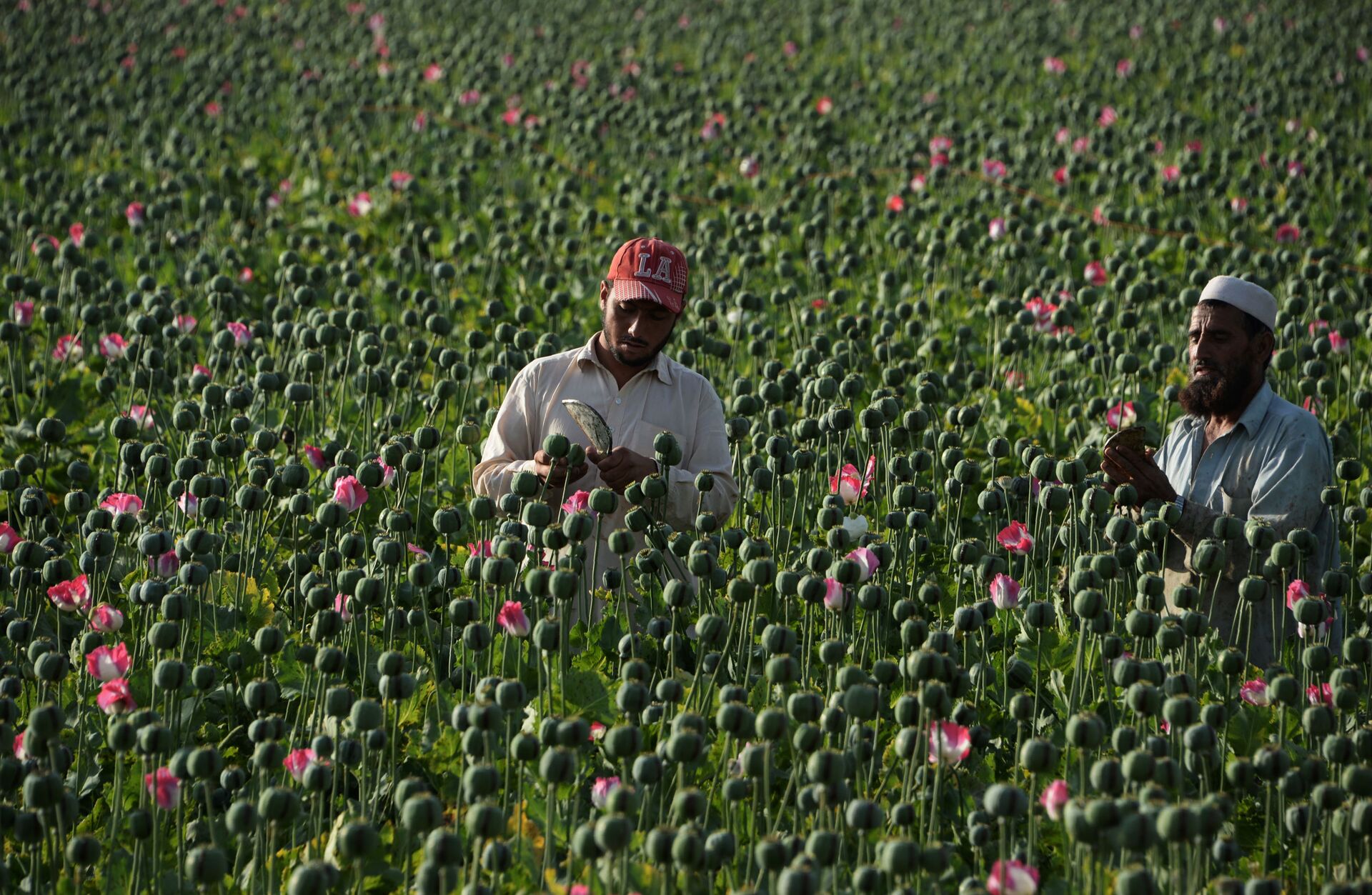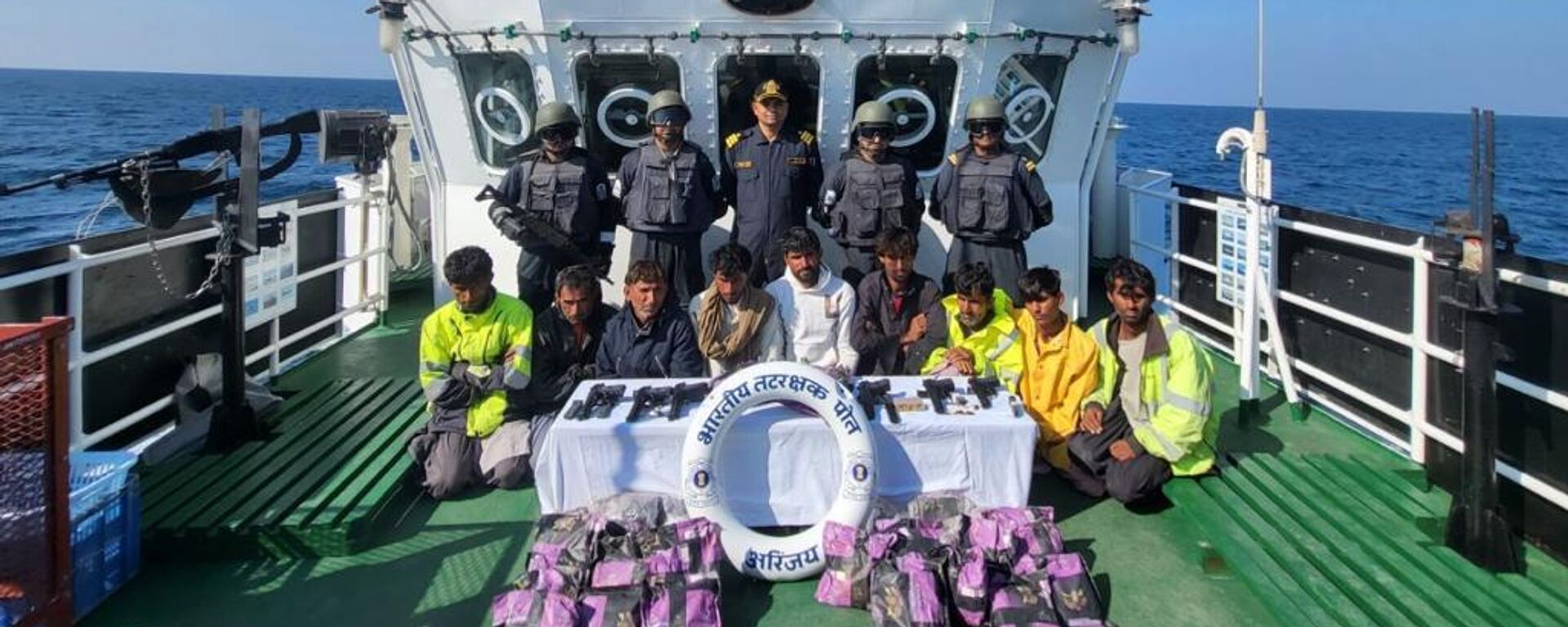https://sputniknews.in/20230129/the-silent-killer-booming-billion-dollar-drug-trade-in-pakistan-683060.html
The Silent Killer: Booming Billion-Dollar Drug Trade in Pakistan
The Silent Killer: Booming Billion-Dollar Drug Trade in Pakistan
Sputnik India
One of the most significant issues facing Pakistan is the cultivation and production of opium. The country is the second largest cultivator of opium in the world, after Afghanistan.
2023-01-29T20:20+0530
2023-01-29T20:20+0530
2023-01-29T22:29+0530
world news
pakistan
drug trafficking
drug smuggling
https://cdn1.img.sputniknews.in/img/07e7/01/1d/684307_0:98:1920:1178_1920x0_80_0_0_8b578c90206789cceadb994a04c397ff.jpg
One of the most significant issues facing Pakistan is the cultivation and production of opium. The country is one of the largest cultivators of opium in the world, following Afghanistan and Myanmar.While a report by the United Nations highlighted that Pakistan provides a vital transit route for the smuggling of drugs worth $30 billion from Afghanistan, it is believed that the illegal drug trade in Pakistan generates $2 billion a year.According to author Allen K. Jones, Southeast Asia was once known as the Golden Triangle of drugs - marijuana and heroin. Today, the Golden Crescent - Iran, Afghanistan, and Pakistan - has overtaken the Triangle as the world's leading region of heroin production. Much of the heroin is smuggled to the West, including the United States. In Pakistan, the poppy plant is cultivated in northern provinces and is then used to produce heroin, which is subsequently smuggled to Iran and China, as well as to Europe and the US.Flourishing CropThe most important areas of Pakistani opium poppy cultivation are the remote, politically autonomous tribal regions of the Northwest Frontier Province (NWFP), along the Afghanistan border, where heroin laboratories can move flexibly between the two countries.Pashtuns living in NWFP consider land ownership one of the most important values of their society. The soil, although not very fertile, is suitable for poppy production so apart from its economic value, the people grow poppy because it is one of the few crops that will flourish on their semi barren land.The poppy plant needs rigorous cultivation and its cash profitability is enormous. A poppy farmer with his annual produce can earn up to 10 times more than he could with tobacco or fruit.In the 1800s, opium was a legal crop grown in these mountains for export under British colonial rule. However, its production and distribution was banned in 1979, when Pakistan's then-military government passed the Hadd Ordinance, based on Islamic regulations.However, the main obstacle to ending poppy production in this region is not the farmers themselves, but the traders.These traders, called VIPs locally (for "vested interest persons"), are the middlemen between the growers and the large-scale smugglers and distributors based in major cities like Peshawar and Lahore.These VIPs are known to be well-armed and have their own private militias. Over the years, there have been reports of traders attacking Pakistani narcotics control officials, even killing some.Despite that, the Pakistani government has made efforts to combat the cultivation and production of opium, including crop eradication programs and alternative development programs to provide farmers with different livelihoods.Nevertheless, these efforts have been hindered by a lack of resources and cooperation from farmers, who often rely on opium cultivation as their primary source of income. They are also afraid that the traders will come after them if they stop growing opium.But the biggest issue is the unverified claims that these traders enjoy protection from high-level government officials.Drug Addiction Among YouthIn addition to opium, Pakistan also faces significant issues with the abuse and trafficking of other drugs, such as marijuana, cocaine, and amphetamines. The majority of these drugs is smuggled into the country from neighboring nations, such as Afghanistan and Iran.The increasing availability of these drugs in Pakistan is contributing to a growing problem of drug addiction among young people in the country.In Pakistan, the total number of drug addicts, according to one UN report, is 7.6 million, 78% of whom are male, while the remaining 22% are female. The number of these addicts is increasing at the rate of 40,000 per year, making Pakistan one of the most drug-affected countries in the world.Abuse of cannabis and heroin, both of which are extremely cheap, is rife in the country.In 2014, Oussama Tawil, UNAIDS country coordinator for Pakistan, noticed a sharp spike in the number of addicts in Pakistan who consume drugs intravenously.He blamed the rise on location, with the most-addicted areas bordering Afghanistan’s fertile poppy growing provinces.Stigma and DiscriminationPoverty, unemployment, and lack of education and awareness are contributing factors to the growing problem of drug addiction in the country. Pakistan's government has made some efforts to combat the abuse and trafficking of other drugs, including law enforcement operations, border control measures, and public awareness campaigns. However, these efforts are often limited by a lack of resources, perceived corruption, and negligible cooperation from local communities.Another issue of drug addiction in Pakistan is further compounded by a lack of access to treatment and rehabilitation services. There is a limited number of rehabilitation centers in the country, and many of these centers lack the resources and trained staff to effectively treat drug addiction.In addition, there is a lack of awareness and understanding of drug addiction among the general population, which often leads to a stigma and discrimination against those struggling with it.The views and opinions expressed in this column are those of the author and do not necessarily reflect the position of Sputnik.
https://sputniknews.in/20221226/india-captures-pakistani-boat-trying-to-smuggle-ammo--drugs-254772.html
pakistan
Sputnik India
feedback.hindi@sputniknews.com
+74956456601
MIA „Rossiya Segodnya“
2023
Aneela Rashid
https://cdn1.img.sputniknews.in/img/07e6/0c/0d/74548_0:0:485:484_100x100_80_0_0_821526e967ae85d041e2d30ee34fa1de.jpg
Aneela Rashid
https://cdn1.img.sputniknews.in/img/07e6/0c/0d/74548_0:0:485:484_100x100_80_0_0_821526e967ae85d041e2d30ee34fa1de.jpg
News
en_IN
Sputnik India
feedback.hindi@sputniknews.com
+74956456601
MIA „Rossiya Segodnya“
Sputnik India
feedback.hindi@sputniknews.com
+74956456601
MIA „Rossiya Segodnya“
Aneela Rashid
https://cdn1.img.sputniknews.in/img/07e6/0c/0d/74548_0:0:485:484_100x100_80_0_0_821526e967ae85d041e2d30ee34fa1de.jpg
drug addiction, drug smuggling, pakistan drug smuggling, stigma in pakistan, opium cultivation, drug addicts
drug addiction, drug smuggling, pakistan drug smuggling, stigma in pakistan, opium cultivation, drug addicts
The Silent Killer: Booming Billion-Dollar Drug Trade in Pakistan
20:20 29.01.2023 (Updated: 22:29 29.01.2023) Narcotics in Pakistan have become a major problem in recent years, with a significant increase in drug abuse and trafficking. The country's location at the crossroads of Central Asia and South Asia as well as its porous borders make it a prime destination for drug traffickers.
One of the most significant issues facing Pakistan is the cultivation and production of opium. The country is one of the largest cultivators of opium in the world, following Afghanistan and Myanmar.
While a report by the United Nations highlighted that Pakistan provides a vital transit route for the smuggling of drugs worth $30 billion from Afghanistan, it is believed that the illegal drug trade in Pakistan generates $2 billion a year. According to author Allen K. Jones, Southeast Asia was once known as the Golden Triangle of drugs - marijuana and heroin. Today, the Golden Crescent - Iran, Afghanistan, and Pakistan - has overtaken the Triangle as the world's leading region of heroin production.
Much of the heroin is smuggled to the West, including the United States. In Pakistan, the poppy plant is cultivated in northern provinces and is then used to produce heroin, which is subsequently smuggled to Iran and China, as well as to Europe and the US.
"A significant amount of heroin that reaches US shores - between 40 and 60 percent, according to reliable sources - comes from the Golden Crescent, most of it from Pakistan," according to Jones.
The most important areas of Pakistani opium poppy cultivation are the remote, politically autonomous tribal regions of the Northwest Frontier Province (NWFP), along the Afghanistan border, where heroin laboratories can move flexibly between the two countries.
Pashtuns living in NWFP consider land ownership one of the most important values of their society. The soil, although not very fertile, is suitable for poppy production so apart from its economic value, the people grow poppy because it is one of the few crops that will flourish on their semi barren land.
The poppy plant needs rigorous cultivation and its cash profitability is enormous. A poppy farmer with his annual produce can earn up to 10 times more than he could with tobacco or fruit.
In the 1800s, opium was a legal crop grown in these mountains for export under British colonial rule. However, its production and distribution was banned in 1979, when Pakistan's then-military government passed the Hadd Ordinance, based on Islamic regulations.
However, the main obstacle to ending poppy production in this region is not the farmers themselves, but the traders.
These traders, called VIPs locally (for "vested interest persons"), are the middlemen between the growers and the large-scale smugglers and distributors based in major cities like Peshawar and Lahore.
These VIPs are known to be well-armed and have their own private militias. Over the years, there have been reports of traders attacking Pakistani narcotics control officials,
even killing some.
Despite that, the Pakistani government has made efforts to combat the cultivation and production of opium, including crop eradication programs and alternative development programs to provide farmers with different livelihoods.
Nevertheless, these efforts have been hindered by a lack of resources and cooperation from farmers, who often rely on opium cultivation as their primary source of income. They are also afraid that the traders will come after them if they stop growing opium.
But the biggest issue is the unverified claims that these traders enjoy protection from high-level government officials.
Drug Addiction Among Youth
In addition to opium, Pakistan also faces significant issues with the abuse and trafficking of other drugs, such as marijuana, cocaine, and amphetamines. The majority of these drugs is smuggled into the country from neighboring nations, such as Afghanistan and Iran.
The increasing availability of these drugs in Pakistan is contributing to a growing problem of drug addiction among young people in the country.
In Pakistan, the total number of drug addicts, according to
one UN report, is 7.6 million, 78% of whom are male, while the remaining 22% are female. The number of these addicts is increasing at the rate of 40,000 per year, making Pakistan one of the most drug-affected countries in the world.
Abuse of cannabis and heroin, both of which are extremely cheap, is rife in the country.
In 2014, Oussama Tawil, UNAIDS country coordinator for Pakistan,
noticed a sharp spike in the number of addicts in Pakistan who consume drugs intravenously.
"In 2007, Pakistan had an estimated 90,000 [injecting drug users] and the number has now risen to around 500,000," Tawil said.
He blamed the rise on location, with the most-addicted areas bordering Afghanistan’s fertile poppy growing provinces.
Stigma and Discrimination
Poverty, unemployment, and lack of education and awareness are contributing factors to the growing problem of drug addiction in the country.
Pakistan's government has made some efforts to combat the abuse and trafficking of other drugs, including law enforcement operations, border control measures, and public awareness campaigns. However, these efforts are often limited by a lack of resources, perceived corruption, and negligible cooperation from local communities.
Another issue of drug addiction in Pakistan is further compounded by a lack of access to treatment and rehabilitation services. There is a limited number of rehabilitation centers in the country, and many of these centers lack the resources and trained staff to effectively treat drug addiction.
In addition, there is a lack of awareness and understanding of drug addiction among the general population, which often leads to a stigma and discrimination against those struggling with it.
The views and opinions expressed in this column are those of the author and do not necessarily reflect the position of Sputnik.




